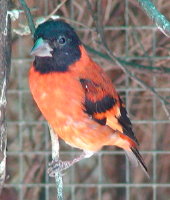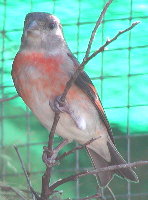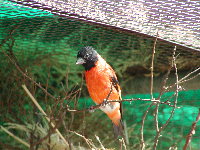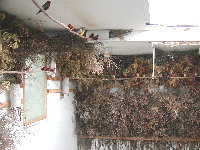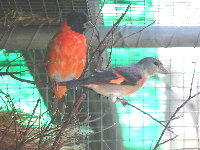Distribution: North-eastern Colombia, Northern Venezuela and Trinidad.
Introduced into Cuba and Puerto Rico.
In 1964 I had my first interstate trip primarily to see other
State's aviculturists and their collections. I remember this well as the
Beatles were in Adelaide at the same time. Firstly, three of us went to
South Australia and had a good look around and then back to Victoria. We met
some really good people who were most helpful to us, one of whom was the
late Fred Lewitzka, of South Australia. He was, at the time, curator of
birds at the Adelaide Zoo.
Fred was the first person in Australia to breed the Orange
Bellied parrot. I also think he was the first to breed the White-bellied
Scarlet, all in his own private collection. Also part of this collection
were, Golden Shouldered parrots and Red Hooded Siskins. I had not seen these
in the flesh before and I, and my friends, were rapt. I made up my mind I
would have to have a pair of Siskins. Despite all the advice and warnings I
received for their well being, care and feeding nothing could have prepared
me for the heartache that followed.
The Siskin is as hard as nails once acclimatised to its new
aviary and surroundings but their requirements must be met. For instance, if
the seed and water have been a certain height off the floor or on the floor
this must be duplicated because the bird will starve to death if it can't
easily get at its food as it doesn't try real hard to seek it out. This
behaviour, of course, is not hard and fast with all Siskins, but because it
is too late after the bird is dead it is best to try very hard to copy its
previous home.
Fred told me all this and much more about its food which was
the basis of me starting with the Siskins. At the time he also told me how
rare the Siskin was in Australia. Although my memory is starting to dim I
think he said that about four other aviculturists in Adelaide has these
birds, also a lady in Sydney and a couple of Victorian aviculturists. I
guess even if one doubled the number because of unknowns, then the Siskin
today can certainly be considered established. I have heard that there are
more Siskins here in aviculture than any other part of the world.
It is very rare in its natural state and is fully protected.
In fact in Australia, it is required to be registered on the Exotic Bird
Registration scheme. That could be a mistake as a lot of Aviculture is
driven by the almighty dollar, and this registration fee seems to have had
the effect of reducing the Siskin's value and along with the registration
scheme of $30 could have the effect of deterring would-be keepers of this
bird from doing so.
Some of the aforementioned heartache is brought about by the
bird's habit of not continuing to brood the young at night anytime from 3
days to 14 days old. This is my observation from my early days of keeping
these birds. It does, of course, vary as to the type of aviary these birds
are kept in and anyone who has heated aviaries has a much better chance of
rearing the young. Leaving the young is one of the most common reasons of
failure to rear. There are many other reasons and several aviculturists I
know in Queensland say it is still common for the young to die and believe
me it must be warmer there than here in Tasmania.
In early days I kept them in planted aviaries and still do
today. I'm sure I could rear many more young by changing their habitat but
that's the way I keep my few pairs and I get a few young every year by being
observant, and trying hard. I have fostered them under canaries and also the
Black-headed Siskin. The latter bird does a terrific job of foster parenting
and although a much bigger bird with bigger eggs they have reared mine from
hatching. However, they cannot be kept with Red-headed Siskin because they
will certainly hybridise as I found out. I never found any imprinting from
this fostering.
Another method is to take the young inside of a night and
replace them in the nest the next morning, but this involves the watching of
the hen up until nearly dark to make sure she is not going to sit that
night, also to make sure the chicks have had a late sustaining feed for the
night. I used to do this religiously in my early days of keeping these
birds. Then the next morning I'd be up early and put a hot hard boiled egg
in their nest to warm it up before replacing the chicks and the parents
would always feed them. Believe me, I earned my early birds. One year I had
eleven young off a couple of pair.
| Fig.3. Male Red-hooded Siskin. |
Fig.4. Red siskin Breeding Aviary. |
Fig.5.
Pair of Siskins. |
In the early days I had followed Fred's feeding
schedule of niger, maw and crushed sunflower. He said always have plain
canary available as at certain times of the year they change their diet so
all this I did and then found that they took plain cake and maggots. Fred
had access to white ants. We don't have these in numbers to sustain constant
feeding, ours are true white ants. Fred's live food were in
fact termites which are not found in Tasmania.
I accidentally trod on some garden snails and found that the
Siskins fed off these a fair bit after they dried out. I told Fred and
others and received all sorts of warnings about flukes on snails but it
seemed to apply to water snails only. I didn't find out whether the Siskins
had eaten the meat or shell or both, anyway in fact, I must say that Siskins
seem to live to a ripe old age in most cases. However, they are susceptible
to air-sac mite and mosquito bites. I have had a couple of Siskins that
their feet swelled up and toes fell off and I suspected mosquito damage.
Strangely, that was years ago, it must have been a particularly bad season.
Back to feeding, I had the pleasure of meeting a big breeder
of Siskins in a suburb of Perth, Western Australia who does not believe in
feeding crushed sunflower but breeds a lot of young Siskins and starts a lot
earlier than we in Tasmania. The season here can start in September and
usually goes until March. Our first frosts can occur in March.
On the subject of heat we have aviculturists here in Tasmania
who do really well with Siskins in an enclosed aviary. One aviary has a
large flight with gravel floor, water bowls and perches, then a partition
with a centre opening that gives birds access to the inside room with
tea-tree lined walls for nesting sites. In there is their seed and various
live foods, such as small meal worms and bush fly maggots and a covered oil
filled heater. (see Fig.4)
Not only the Siskins but other exotic birds do exceptionally
well in this situation. There are shutters over the wire openings from the
outside that are opened in the day and closed at night. The aviaries in
Perth that I saw were part opened on the roof as are mine, but they have
different night temperatures I am sure.
Another way I keep the young birds warm is a very clever
device designed by a Northern Tasmanian aviculturist. It is a pipe 2025mm
wide by about 2.4m high with a heavy base. On this is a vertical travelling
and locking unit that has on it a ceramic socket to take a 150 watt
porcelain globe. This unit can be placed near a Siskin's nest and the heat
only globe can direct the heat centre about 450-600mm to the nest of young
Siskins. This support is only needed through the night and by working it
closer as the hen sits she gets used to its proximity and when she doesn't
sit, providing you have observed she is not going to sit, it can be switched
on late afternoon and turned off early in the morning. This unit has been a
life saver of many young Siskins.
I would say if you are prepared for some heartache at first,
until you get to know the best way to look after your Siskins at breeding
time then they will at least stay healthy for you for a long time and should
be fertile for up to eight years or so. As they get older they take on more
colour or the hens do. There is a fair difference in the colour of cock
birds from light orange to a beautiful, almost red, colour. Colour can vary
a lot even though they all have access to the same food.
I run several pairs to an aviary although single pairs would
perhaps do better in smaller aviaries.
For nesting material I use clean very fine teased and chopped
sheep wool (I use scissors to do that), plus cotton wool and coconut fibre,
hessian and hot pipe legging. All this nest building material must be pinned
or pegged in a wire netting purse or any other method that holds it firm as
the hen will only take small pieces at a time. Nests vary in height from the
ground and can be in any situation, though they seem to prefer dead bracken
fern and brush.
I think the cock bird finds the nest spot and the hen builds
the nest with virtually no help but lots of attention. I have found that the
hen Siskin will finish her nest then wait about 4 to 5 days before she lays.
This used to play havoc in trying to get foster canaries and I would have to
pull the canaries' nest apart several times to coincide with the Siskins. If
I wanted to put the young Siskins in the canaries' nests after they had been
part reared by their parents I planned 4 to 5 days in age in front of the
canary because of the length of neck stretch for food. The Siskin's neck
isn't as long.
When the hen Siskin is ready to lay she will usually lay 2 to
4 eggs. Fertility is approximately 50 to 80% and sometimes 100% from 4 eggs.
Four young are really to big for the nest size but, of course, are very good
to see. The hen nest feeds and broods alone until the young birds fledge,
although some cock birds will help feed in the nest and some will only feed
after fledging. In most cases I think the young survive because of the hen.
Once out of the nest young birds are a worry. In my aviaries
if the weather turns bad, you will always find the young in the most
vulnerable place for the night's roosting, always as high as they can get
and always in the open and as they sit very still it's very hard to see them
to move them to a better spot.
So, from all this you can see it is better to have them in a
controlled situation unless you are prepared to really look after them.
These birds are wonderful inmates to any aviary and if you are prepared for
the challenge then they are most rewarding. The cock has a beautiful song
and really rivals canaries with whom they will also cross, hence the origin
of the Red Factor canary.
Many years ago I did cross a canary hen with a spare cock
Siskin hoping any young hens would be a good foster parent for rearing
Siskins. Strangely enough, I reared four young, all hens, and none proved
any good at nesting.
Well, that's about all I can recall in my keeping Red Siskins
but these days I still enjoy keeping and breeding from several pairs of this
delightful bird.
Copyright remains with the author. Please do not reprint without
permission!
|
